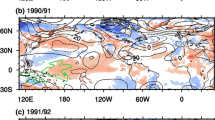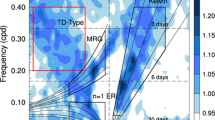Abstract
Differences in convective activities in the tropical region (30°S–30°N, 180°E–180°W) during different phases of the quasi-biennial oscillation (QBO) are investigated over 32 years (1979–2010) using five metrics representing tropical convection: (i) precipitation and (ii) outgoing longwave radiation from observations and (iii) convective available potential energy (CAPE), (iv) deep convective heating rate, and (v) convective cloud top pressure from reanalysis data. The easterly (QBOE) and westerly (QBOW) phases of the QBO are defined using the zonal wind anomaly from the monthly climatology at 50 hPa. During the QBOE (QBOW), the convective activities are intensified (weakened) over the Maritime Continent and weakened (intensified) over the equatorial eastern and central Pacific. Therefore, the zonal mean values of the five metrics averaged over chronically convective regions show stronger convective activities during the QBOE than during the QBOW, while the opposite is true for the whole tropical region. Composite analyses are also performed during the neutral, El Niño, and La Niña periods. In the neutral period, the convective activities during QBOE are stronger than during QBOW except in the equatorial region (10°S–10°N). The convective activities over the Maritime Continent (central and eastern Pacific) are enhanced when La Niña and the QBOE (El Niño and the QBOW) occur simultaneously. All metrics show similar pattern to one another, implying that the metrics from reanalysis data represent the variations in the convective activities with respect to the QBO reasonably well. Among the five metrics, the CAPE is most sensitive to the QBO phase, likely because the virtual temperature in the upper troposphere is modulated by anomalous meridional circulations induced by different QBO phases.














Similar content being viewed by others
References
Adams, D.K., Souza, E.P.: CAPE and convective events in the southwest during the north American monsoon. Mon. Weather Rev. 137, 83–98 (2009). https://doi.org/10.1175/2008MWR2502.1
Adler, R.F., et al.: The Version-2 global precipitation climatology project (GPCP) monthly precipitation analysis (1979–present). J. Hydrometeorol. 4, 1147–1167 (2003). https://doi.org/10.1175/1525-7541(2003)004<1147:TVGPCP>2.0.CO;2
Arakawa, A., Schubert, W.H.: Interaction of a cumulus cloud ensemble with the large-scale environment, part I. J. Atmos. Sci. 31, 674–701 (1974). https://doi.org/10.1175/1520-0469(1974)031<0674:IOACCE>2.0.CO;2
Baldwin, M.P., et al.: The Quasi-Biennial Oscillation. Rev. Geophys. 39, 179–229 (2001). https://doi.org/10.1029/1999RG000073
Camargo, S.J., Sobel, A.H.: Revisiting the influence of the quasi-biennial oscillation on tropical cyclone activity. J. Clim. 23, 5810–5825 (2010). https://doi.org/10.1175/2010JCLI3575.1
Claud, C., Terray, P.: Revisiting the possible links between the quasi-biennial oscillation and the Indian summer monsoon using NCEP R-2 and CMAP fields. J. Clim. 20, 773–787 (2007). https://doi.org/10.1175/JCLI4034.1
Collimore, C.C., Martin, D.W., Hitchman, M.H., Huesmann, A., Waliser, D.E.: On the relationship between the QBO and tropical deep convection. J. Clim. 16, 2552–2568 (2003). https://doi.org/10.1175/1520-0442(2003)016<2552:OTRBTQ>2.0.CO;2
Du, Y., Zhang, Y., Feng, M., Wang, T., Zhang, N., Wijffels, S.: Decadal trends of the upper ocean salinity in the tropical indo-Pacific since mid-1990s. Sci. Rep. 5, 16050 (2015). https://doi.org/10.1038/srep16050
Emanuel, K. A.: Atmospheric Convection. Oxford University Press, 580 pp. (1994).
Garfinkel, C.I., Hartmann, D.L.: The influence of the quasi-biennial oscillation on the troposphere in wintertime in a hierarchy of models. Part II: perpetual winter WACCM runs. J. Atmos. Sci. 68, 2026–2041 (2011). https://doi.org/10.1175/2011JAS3702.1
Geller, M.A., Zhou, T., Yuan, W.: The QBO, gravity waves forced by tropical convection, and ENSO. J. Geophys. Res. Atmos. 121, 8886–8895 (2016). https://doi.org/10.1002/2015JD024125
Giorgetta, M.A., Bengtsson, L.: Potential role of the quasi-biennial oscillation in the stratosphere-troposphere exchange as found in water vapor in general circulation model experiments. J. Geophys. Res. 104, 6003–6020 (1999). https://doi.org/10.1029/1998JD200112
Giorgetta, M.A., Bengtsson, L., Arpe, K.: An investigation of QBO signals in the east Asian and Indian monsoon in GCM experiments. Clim. Dyn. 15, 435–450 (1999). https://doi.org/10.1007/s003820050292
Gray, W.M.: Atlantic seasonal hurricane frequency. Part I: El Niño and 30 mb quasi-biennial oscillation influences. Mon. Weather Rev. 112, 1649–1668 (1984). https://doi.org/10.1175/1520-0493(1984)112<1649:ASHFPI>2.0.CO;2
Gray, W.M., Scheaffer, J.D., Knaff, J.A.: Influence of the stratospheric QBO on ENSO variability. J. Meteorol. Soc. Jpn. 70, 975–995 (1992). https://doi.org/10.2151/jmsj1965.70.5_975
Han, W., et al.: Intensification of decadal and multi-decadal sea level variability in the western tropical Pacific during recent decades. Clim. Dyn. 43, 1357–1379 (2014). https://doi.org/10.1007/s00382-013-1951-1
Hansen, F., Matthes, K., Wahl, S.: Tropospheric QBO–ENSO interactions and differences between the Atlantic and Pacific. J. Clim. 29, 1353–1368 (2016). https://doi.org/10.1175/JCLI-D-15-0164.1
Ho, C.-H., Kim, H.-S., Jeong, J.-H., Son, S.-W.: Influence of stratospheric quasi-biennial oscillation on tropical cyclone tracks in western North Pacific. Geophys. Res. Lett. 36, L06702 (2009). https://doi.org/10.1029/2009GL037163
Holton, J.R., Lindzen, R.S.: An updated theory for the quasi-biennial cycle of the tropical stratosphere. J. Atmos. Sci. 29, 1076–1080 (1972). https://doi.org/10.1175/1520-0469(1972)029<1076:AUTFTQ>2.0.CO;2
Huang, B., Hu, Z.-Z., Kinter III, J.L., Wu, Z., Kumar, A.: Connection of stratospheric QBO with global atmospheric general circulation and tropical SST. Part I: Methodology and composite life cycle. Clim. Dyn. 38, 1–23 (2012). https://doi.org/10.1007/s00382-011-1250-7
Huesmann, A.S., Hitchman, M.H.: The stratospheric quasi-biennial oscillation in the NCEP reanalyses: climatological structures. J. Geophys. Res. 106, 11859–11874 (2001). https://doi.org/10.1029/2001JD900031
Huffman, G.J., Adler, R.F., Bolvin, D.T., Gu, G., Nelkin, E.J., Bowman, K.P., Hong, Y., Stocker, E.F., Wolff, D.B.: The TRMM multisatellite precipitation analysis (TMPA): quasi-global, multiyear, combined-sensor precipitation estimates at fine scales. J. Hydrometeorol. 8, 38–55 (2007). https://doi.org/10.1175/JHM560.1
Kane, R.P.: Comparison of stratospheric zonal winds and El Nino southern oscillation in recent decades. Int. J. Climatol. 24, 525–532 (2004). https://doi.org/10.1002/joc.1004
Kim, Y.-H., Chun, H.-Y.: Contributions of equatorial wave modes and parameterized gravity waves to the tropical QBO in HadGEM2. J. Geophys. Res. Atmos. 120, 1065–1090 (2015). https://doi.org/10.1002/2014JD022174
Lee, H.-T.: Climate Algorithm Theoretical Basis Document (C-ATBD): Outgoing Longwave Radiation (OLR) - Daily. NOAA’s Climate Data Record (CDR) Program, CDRP-ATBD-0526, 46 pp. (2014). http://www1.ncdc.noaa.gov/pub/data/sds/cdr/CDRs/Outgoing%20Longwave%20Radiation%20-%20Daily/AlgorithmDescription.pdf
Liess, S., Geller, M.A.: On the relationship between QBO and distribution of tropical deep convection. J. Geophys. Res. 117, D03108 (2012). https://doi.org/10.1029/2011JD016317.
Naujokat, B.: An update of the observed quasi-biennial oscillation of the stratospheric winds over the tropics. J. Atmos. Sci. 43, 1873–1877 (1986). https://doi.org/10.1175/1520-0469(1986)043<1873:AUOTOQ>2.0.CO;2
Nie, J., Sobel, A.H.: Responses of tropical deep convection to the QBO: cloud-resolving simulations. J. Atmos. Sci. 72, 3625–3638 (2015). https://doi.org/10.1175/JAS-D-15-0035.1
Pan, H.-L., and W.-S. Wu: Implementing a mass flux convective parameterization package for the NMC medium-range forecast model. NMC Office Note 409, 40 pp. (1995). http://www2.mmm.ucar.edu/wrf/users/phys_refs/CU_PHYS/Old_SAS.pdf.
Plumb, R.A., Bell, R.C.: A model of the quasi-biennial oscillation on an equatorial beta-plane. Q. J. R. Meteorol. Soc. 108, 335–352 (1982). https://doi.org/10.1002/qj.49710845604
Reed, R.J., Campbell, W.J., Rasmussen, L.A., Rogers, R.G.: Evidence of a downward propagating annual wind reversal in the equatorial stratosphere. J. Geophys. Res. 66, 813–818 (1961). https://doi.org/10.1029/JZ066i003p00813
Reid, G.C., Gage, K.S.: Interannual variations in the height of the tropical tropopause. J. Geophys. Res. 90, 5629–5635 (1985). https://doi.org/10.1029/JD090iD03p05629
Saha, S., et al.: The NCEP climate forecast system reanalysis. Bull. Am. Meteorol. Soc. 91, 1015–1057 (2010). https://doi.org/10.1175/2010BAMS3001.1
Schirber, S.: Influence of ENSO on the QBO: results from an ensemble of idealized simulations. J. Geophys. Res. Atmos. 120, 1109–1122 (2015). https://doi.org/10.1002/2014JD022460
Seo, J., Choi, W., Youn, D., Park, D.S.R., Kim, J.Y.: Relationship between the stratospheric quasi-biennial oscillation and the spring rainfall in the western North Pacific. Geophys. Res. Lett. 40, 5949–5953 (2013). https://doi.org/10.1002/2013GL058266
Son, S.-W., Lim, Y., Yoo, C., Hendon, H.H., Kim, J.: Stratospheric control of madden–Julian oscillation. J. Clim. 30, 1909–1922 (2017). https://doi.org/10.1175/JCLI-D-16-0620.1
Taguchi, M.: Observed connection of the stratospheric quasi-biennial oscillation with El Niño–southern oscillation in radiosonde data. J. Geophys. Res. 115, D18120 (2010). https://doi.org/10.1029/2010JD014325.
Tompkins, A.M.: Organization of tropical convection in low vertical wind shears: the role of water vapor. J. Atmos. Sci. 58, 529–545 (2001). https://doi.org/10.1175/1520-0469(2001)058<0529:OOTCIL>2.0.CO;2
Waliser, D.E., Graham, N.E., Gautier, C.: Comparison of the highly reflective cloud and outgoing longwave radiation datasets for use in estimating tropical deep convection. J. Clim. 6, 331–353 (1993)
Wang, W., Xie, P., Yoo, S.-H., Xue, Y., Kumar, A., Wu, X.: An assessment of the surface climate in the NCEP climate forecast system reanalysis. Clim. Dyn. 37, 1601–1620 (2011). https://doi.org/10.1007/s00382-010-0935-7
Williams, E., Renno, N.: An analysis of the conditional instability of the tropical atmosphere. Mon. Weather Rev. 121, 21–36 (1993)
Xue, X., Chen, W., Chen, S., Zhou, D.: Modulation of the connection between boreal winter ENSO and the south Asian high in the following summer by the stratospheric quasi-biennial oscillation. J. Geophys. Res. Atmos. 120, 7393–7411 (2015). https://doi.org/10.1002/2015JD023260
Yoo, C., Son, S.-W.: Modulation of the boreal wintertime madden–Julian oscillation by the stratospheric quasi-biennial oscillation. Geophys. Res. Lett. 43, 1392–1398 (2016). https://doi.org/10.1002/2016GL067762
Yuan, W., Geller, M.A., Love, P.T.: ENSO influence on QBO modulations of the tropical tropopause. Q. J. R. Meteorol. Soc. 140, 1670–1676 (2014). https://doi.org/10.1002/qj.2247
Zhang, C., Zhang, B.: QBO-MJO connection. J. Geophys. Res. Atmos. 123, 2957–2967 (2018). https://doi.org/10.1002/2017JD028171
Zhou, X., Geller, M.A., Zhang, M.: Tropical cold point tropopause characteristics derived from ECMWF reanalyses and soundings. J. Clim. 14, 1823–1838 (2001). https://doi.org/10.1175/1520-0442(2001)014<1823:TCPTCD>2.0.CO;2
Acknowledgments
This work was funded by the Korea Meteorological Administration Research and Development Program under Grant KMIPA 2015-6160.
Author information
Authors and Affiliations
Corresponding author
Additional information
Responsible Editor: Ben Jong-Dao Jou, PhD.
Electronic supplementary material
ESM 1
(PDF 1129 kb)
Rights and permissions
About this article
Cite this article
Lee, JH., Kang, MJ. & Chun, HY. Differences in the Tropical Convective Activities at the Opposite Phases of the Quasi-Biennial Oscillation. Asia-Pacific J Atmos Sci 55, 317–336 (2019). https://doi.org/10.1007/s13143-018-0096-x
Received:
Revised:
Accepted:
Published:
Issue Date:
DOI: https://doi.org/10.1007/s13143-018-0096-x




